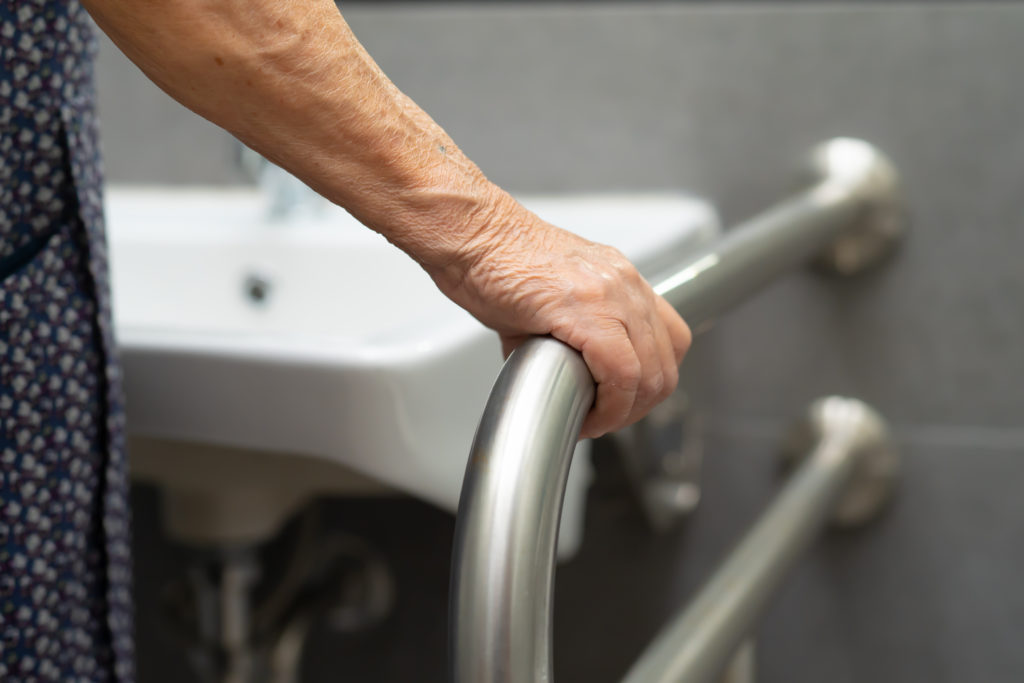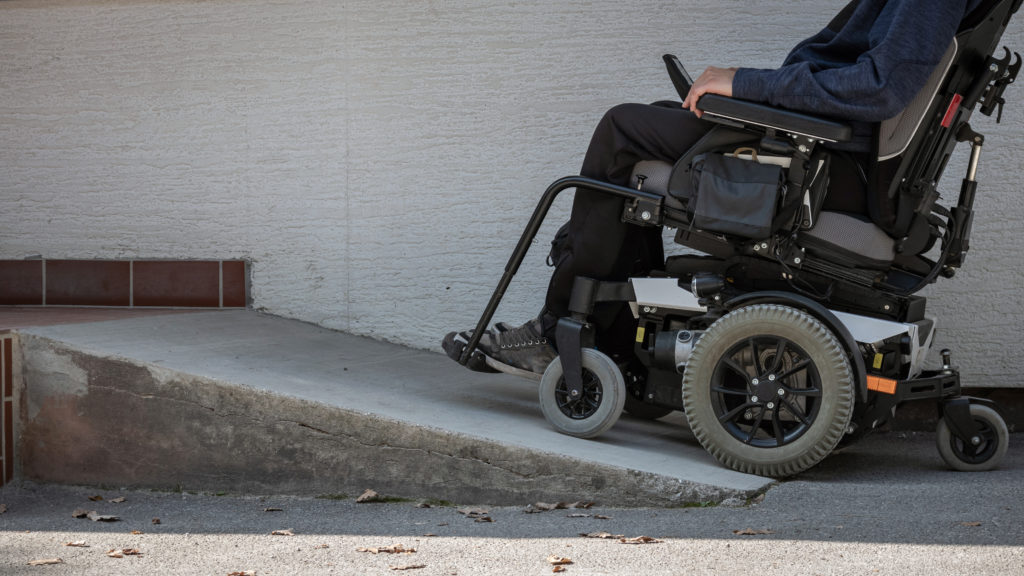Blog Brought to you by Senior Housing
Edited by Travis Doss, REALTOR® & Relocation Expert
Reviewed by: Deidre Sommerer, LPN, MS, CMC, CDP
Published/updated: September 10, 2022
They say home is where the heart is, and America’s seniors seem to agree. Aging in place is an increasingly popular retirement option, and many retirees relish the idea of staying in the home they love for years to come. In fact, a survey from the AARP found that 77% of older adults want to remain in their homes as they age. However, accessibility issues could make this goal less realistic; in the same survey, 71% of respondents indicated that their home has accessibility problems. For the two in five individuals aged 65 and older who have a disability, these problems could make aging in place challenging at best and dangerously unsafe at worst.
Home modifications are an essential part of ensuring that a home remains safe, secure and comfortable for aging seniors to enjoy throughout their retirement years. Whether you’re considering home modifications for yourself or a loved one, this guide can serve as a valuable resource. It covers the ins and outs of home modifications for disabled seniors, including where to start, what to prioritize and what federal resources are available to make the process easier.
Planning Your Remodeling Project: Where to Start
When it comes to home remodeling projects, it’s not always easy to know where to start. This is especially true when it comes to planning a remodel for the purposes of accessibility and safety. Use the steps below to begin planning your home remodeling project.
Evaluate Your Home
The first step of any remodeling project is to evaluate your home to get an accurate idea of what modifications need to take place. Some key questions to ask during this stage include:
- Is the entranceway easily accessible? Are ramps needed?
- Is the home well-lit with adequate light switches?
- Is there a bedroom on the main floor of the house? If not, could it accommodate one?
- Are there handrails on all the staircases?
- Can the staircases accommodate a stairlift system?
- Can you safely access a phone or emergency alert system from every room?
- Are all area rugs and runners secured to the floor?
- Are all carpets free from fraying edges and secured to avoid tripping hazards?
- Is the hard flooring throughout the house slip-resistant?
- Are the floors free from tripping hazards, such as electrical cords and clutter?
- Is there a walk-in shower or tub available? If not, can the bathroom accommodate one?
- Can a wheelchair or walker safely move about the home?
Hire an Expert
If your home modification plans include large-scale projects, such as remodeling the bathroom or installing a stairlift, it’s best to hire a professional to get the job done safely. Even the most well-meaning amateur handymen can falter when it comes to dealing with complicated jobs, such as rewiring electricity, knocking down walls or widening doorways, and poorly constructed home remodels can do more harm than good. Paying architects, designers and contractors will add to the cost of your remodel, but it could save you from making expensive mistakes during the process.
Consider Working With Certified Aging-in-Place Specialists (CAPS)
The National Association of Home Builders and AARP developed the certified aging-in-place program to train specialists to help seniors and their families identify accessibility issues in the home and make a plan for accessibility solutions. Certified aging-in-place specialists (CAPS) include professionals, such as remodelers, designers and occupational therapists, who understand the unique needs of seniors looking to safely age at home. They have the experience and knowledge necessary to make impactful modifications with usability and accessibility in mind.
Some of the services a certified aging-in-place specialist performs include:
- Evaluating your home and making expert recommendations on updates and modifications that will help you age in place
- Collaborating with other professionals, including contractors and interior designers, to implement accessible building strategies and techniques
- Working with an occupational therapist to develop a personalized home safety modification plan based on your needs
- Overseeing the remodeling project from beginning to end and following up to see if any further modifications are needed
You can find a CAPS professional in your area by visiting the NAHB’s online directory page or by calling (800) 368-5242.
Other Resources for Finding Certified Professionals
Additional resources you can use to find high-quality professionals in your area include:
- Your local Better Business Bureau and Chamber of Commerce
- ADA certified contractor directories
- Recommendations from trusted family and friends
Structural Home Safety Modifications
Aging in place often necessitates making structural changes to your home in order to accommodate wheelchairs, walkers, hospital beds, transfer lifts and other assistive devices. Consider making the changes below to make your home accessible.
Modifications for Accessible Approaches, Landscapes and Doorways
Widen Doorways
As a general rule, people who utilize wheelchairs and walkers can safely pass through doorways that are at least 36 inches wide, although 42 inches wide is ideal for ease of use.
Install Ramps
Ramps leading to the exterior doorways of the home allow wheelchair users and seniors with mobility difficulties to safely access the home. To meet ADA requirements, ramps must be a minimum of 36 inches wide, with a maxim slope of 1:12. Landing sizes must be at least 5 square feet, and the ramp must have handrails on both sides if the rise is greater than 6 inches or the ramp is longer than 72 inches.
Ensure a 5-Foot Turning Radius
Wheelchairs generally need a minimum of a 5-foot turning radius to allow users to safely traverse the home.
Disability-Friendly Flooring
Slippery surfaces and flooring are hazardous for seniors with disabilities. Disability-friendly flooring satisfies the following requirements:
- Slip-resistant
- Firm
- Stable with traction
- Smooth and not uneven or bumpy
The following flooring types are good choices for a disability-friendly home:
- Ceramic or porcelain tile
- Vinyl flooring
- Laminate flooring
- Engineered hardwood
If any area rugs or runners are used throughout the home, they should be safely secured with anti-slip tape or adhesives. This not only reduces the risk of trip and fall accidents, but it also ensures that wheelchairs and walkers won’t get caught on the rugs.
Modifications for Multistory Homes
Stairlifts
Stairlifts are motorized chairs designed to help seniors and people with disabilities safely travel up and down the stairs in their home independently. These lifts use a power-operated motorized gear to move on demand. There are three main types of stairlifts:
- Straight Rail Stairlifts: Used for straight flights of stairs without any tuns
- Curved Rail Stairlifts: Used for stairs that have a curve, turn or other change in direction
- Outdoor Stairlifts: Used for stairs located outside of the home
Stairlifts can be customized to fit the specifications of your home’s staircase, and some models come with upgrades, such as a remote control.
Home Elevators
If the stairs in your home are too narrow for a stairlift, a home elevator is a good alternative. Installing a home elevator is a large expense, but elevators are an efficient way to help disabled seniors access rooms on the upper levels of their homes. Home elevators are quiet, safe and compatible with a wide variety of home configurations. Below, we’ll take a look at the most popular types of home elevators.
Hydraulic Elevators
Hydraulic elevators are supported by a piston that pushes the elevator up or down with the help of an electric motor that forces a flow of hydraulic fluid. These elevators are a great choice for heavy use and carrying large amounts of weight.
Pros:
- The large cab can easily fit a wheelchair and supports 750-1000 pounds.
- The manual lowering system can be used in the event of an emergency.
- Hydraulic elevators are generally quiet.
Cons:
- You’ll need to make sure you have enough available space for the elevator’s machine room.
- A hydraulic elevator can raise your home’s energy consumption because of its electric motor.
- Hydraulic elevators only travel at a maximum speed of 200 feet per minute.
Traction Elevators
Traction elevators raise and lower with the help of ropes that pass over a wheel attached to an electric motor located above the shaft. Like other elevator types, this system uses a counterweight to eliminate the weight of the occupants and the car, so the motor can do its job more efficiently.
Pros:
- These elevators don’t require a separate machine room.
- Traction elevators are more energy-efficient and require less maintenance than hydraulic elevators.
- Traction elevators usually travel faster than hydraulic elevators.
Cons:
- Traction elevators aren’t recommended for areas prone to earthquakes because of the suspension mechanism.
Vacuum Elevators
Vacuum or pneumatic elevators use a powerful vacuum pump to create air pressure and move the cab to move up and down between floors. These elevators are designed as clear glass tubes with cabs that can accommodate one to three passengers.
Pros:
- You can take your vacuum elevator with you if you move to a different house.
- Vacuum elevators are more compact than other elevator types.
- Installation is less expensive than other elevator types.
- If a power outage occurs, the cab automatically descends to the lowest floor.
Cons:
- Vacuum elevator cabs tend to be smaller, although larger models can accommodate wheelchairs.
- The maximum weight capacity is only 525 pounds.
Home Safety Modifications Room by Room

Modifications for Accessible Bathrooms
Slick, wet surfaces in the bathroom create an especially hazardous environment for seniors with disabilities. Given that 80% of falls occur in the bathroom, it’s crucial to make this space accessible. The following modifications can reduce the risk of falls and help seniors use the bathroom safely.
| Bathroom Features. | Accessibility Challenges | Modifications |
| Showers and Bathtubs | Getting in and out of the bathtub can be a challenge for seniors with mobility issues. Additionally, wheelchair users can’t get in and out of a standard bathtub unassisted.Seniors may fall when entering or exiting the bathtub or shower, or they may not be able to safely stand long enough to take a shower. | Installing grab bars in and around the shower and bathtub can make it easier for seniors to get in and out safely.Curbless showers and walk-in tubs are also good modifications, particularly for wheelchair users and seniors with mobility challenges. Shower seats and tub slide benches can provide a safe place to sit while in the shower to reduce the risk of falls. |
| Toilets | Wheelchair users can have trouble getting on and off standard height toilets. Seniors with mobility challenges can struggle with safely getting on and off the toilet. | Installing a grab bar near the toilet can provide support. Comfort-height toilet seats can make side transfers from wheelchairs easier. |
| Sinks | Standard-height sinks are difficult to reach while using a wheelchair. | Wall-mounted sinks installed no higher than 34 inches from the floor are easier for wheelchair users to access.Faucets with lever handles are easier to turn on and off for people with mobility challenges. |
| Rugs and flooring | Unsecured bathroom rugs create tripping hazards and increase the risk of falls. Slippery floors are also a fall risk. | Non-slip vinyl flooring is a safe choice for the bathroom. It’s also important to add anti-slip strips and mats underneath every rug in the bathroom. |
| Cabinets and Storage | Bathroom cabinets and storage spaces may be difficult to access for wheelchair users. | Bathroom storage spaces should be built no higher than 34 inches from the floor for maximum accessibility. |
Modifications for Accessible Bedrooms
Bedrooms present a variety of challenges when it comes to accessibility and safety. The following modifications can ensure seniors remain safe and secure when they retire to bed for the night.
| Bedroom Features | Accessibility Challenges | Modifications |
| Beds | Getting in and out of bed can be challenging for seniors with limited mobility. Seniors may be at risk of falling while getting in and out of bed, and some may fall out of bed in the middle of the night. Some beds and bed frames may be too high for seniors to safely access. | Bed rails prevent falls or rolling out of bed and provide support for getting in and out of bed. Some bed rails may come with additional safety features, such as an LED nightlight, ergonomic grips and a height-adjustable grab bar. Bed steps can help seniors with mobility issues safely step up and down to get in and out of a high bed. A senior’s dog or cat can also use bed steps, which can prevent the senior from having to lift them onto the bed. Pressure-reducing support surfaces can prevent bedsores from developing in seniors who are largely bed-bound. |
| Closets | Closet shelves may be too high for seniors to safely access without a step stool.Walk-in closets may be cluttered or otherwise full of tripping hazards. Closets may not have adequate lighting for seniors to see inside. Closet doors may be difficult for seniors with arthritis to open. | Automatic closet lights can improve visibility. Lowering closet shelves can make it easier for seniors to safely access them. Lever door handles are easier for seniors with arthritis or low hand mobility to operate. |
| Lighting | Seniors may be unable to turn off the lights without getting out of bed. The bedroom may be poorly lit at night. Traditional light switches are harder for seniors with arthritis and limited hand mobility to operate. | Rocker-style light switches are larger and require less effort to use than traditional switches. Automatic LED nightlights can help maintain visibility at night. Voice-activated, remote-controlled or automated lights can allow seniors to turn off the lights without getting out of bed. |
| Rugs and flooring | Unsecured bedroom rugs create tripping hazards and increase the risk of falls. | It’s important to add anti-slip strips and mats underneath every rug in the bedroom. |
| Nighttime routines | Seniors may need to use the bathroom in the middle of the night, which increases the risk of a fall when getting out of bed and navigating to the bathroom. | Commode chairs (portable toilets) can be placed near the bed, so seniors won’t have to travel far to relieve themselves. |
| Bedside phones | Seniors should be able to access a phone to call for help in the event of an emergency at night. | Keeping a phone by the bedside gives seniors an easy way to call for help when necessary. A corded landline phone provides additional security by ensuring seniors can call for help, even during a power outage. |
Modifications for Accessible Kitchens
Seniors aging at home will likely want to prepare meals on their own, but kitchens present numerous accessibility challenges, ranging from access issues to the risk of fires and burns. The following modifications can help seniors use their kitchens safely.
| Kitchen Features | Accessibility Challenges | Modifications |
| Countertops and Cabinetry | Bending over to access lower cabinets can be difficult. Upper cabinets may be out of reach without a step stool, increasing the risk of falls. | Pull-out shelves reduce strain caused by bending over to open cabinets. Pull-down shelves make it easier to access upper cabinets without reaching. |
| Appliances | If appliances are located too far from each other, seniors may have to move around too much to prepare meals. Ovens or microwaves may be too high to access. Gas ranges increase the risk of fires and burns. | Built-in appliances take up less counter space and can be installed close to each other. Wall-mounted ovens can be installed at accessible heights. Cooktops cool down faster and reduce the risk of fires. |
| Sinks | Standard sinks may be too high for wheelchair users to use. Faucets and sprayers can be difficult to reach. Scalding water can result in burns. | Motorized sinks can be raised or lowered to accommodate wheelchair users. Hands-free or lever-handle faucets can increase accessibility. Anti-scald devices prevent burns and injury. |
| Refrigerators | Refrigerators with wide doors have a wider swing radius that could make them harder for wheelchair users to open. Refrigerator door handles may be difficult to open. | Side-by-side refrigerator/freezer units have a narrower swing radius and make it easier for seniors to access both compartments. Long continuous door handles make them easier to grip at multiple points. Some refrigerators have slide-out shelves and bins to make items easier to access. |
How Smart Home Technology Can Make it Easier to Age in Place
Smart devices aren’t just a modern convenience. They’re also a valuable tool for disabled seniors who want to age safely at home. The following technologies are a few of the many smart home innovations that can help seniors stay safe at home.
Video Doorbells
Video doorbells make it easy for seniors to see who’s at the door from a smartphone app, so they don’t have to get up and check for themselves. This not only keeps disabled seniors from having to make their way to the front door every time the doorbell rings, but it also helps them stay safe from potential intruders.
Many video doorbells also include two-way audio, so seniors can have a conversation with the person outside and determine whether they should answer the door. Some models even include safety features, such as facial recognition, motion capture and cloud video storage.
Smart Door Locks
Smart door locks make it easy for seniors to lock and unlock the front door with a smartphone or voice command. This can make it easier for first responders and loved ones to get into the home in the event of an emergency. Seniors can provide the pin for their smart door locks to trusted loved ones or share it with EMS dispatchers if they call for help.
Voice-controlled Smart Hubs
Smart hubs, such as Amazon Echo and Google Nest, offer a wide range of benefits for seniors. With simple voice commands, they can turn off the lights, adjust the temperature, turn on the TV, close the blinds, call loved ones, and set reminders. If the smart hub doesn’t recognize their voice, they can utilize smartphone apps to execute the same commands.
Smart hubs are also valuable home automation tools. For example, they can be configured to automatically turn off the lights at a certain time, so seniors don’t have to get out of bed to do it.
Smart Displays and Tablets
Smart displays offer the benefits of a tablet and a smart hub speaker rolled into one. Along with home automation commands, smart displays also make it easy for seniors to video call their loved ones or view what’s happening outside their home through connected video cameras. Smart displays can also be configured with large text, screen readers and other accessibility features to help seniors with disabilities use the device.
Lost Item Trackers
Lost item trackers, such as Tile Mates and Apple AirTags, use Bluetooth and GPS technology to help users keep track of their valuables. These can be useful for frequently misplaced items, such as a cell phone, a wallet and keys. Instead of having to search the home for these items, seniors can pull up an app and see exactly where they left them. Since forgetfulness can increase with age, lost item trackers can save seniors from frustration.
Federal Resources for Veterans, Seniors and People with Disabilities

Fair Housing Act
The Fair Housing Act protects people of one or more protected classes from discrimination when it comes to renting, buying or financing a home. The following are recognized as protected classes under the Fair Housing Act:
- Race
- National origin
- Religion
- Sex
- Disability
- Familial status
People with disabilities are protected from discrimination in all types of housing transactions under the Fair Housing Act. This means it’s against the law for a landlord or property owner to refuse to rent a home to someone because of their disability.
The Fair Housing Act also requires housing providers to make reasonable accommodations for a tenant’s disability and to allow tenants to make modifications to the residence to accommodate their disability. Reasonable accommodations could include reserving an accessible parking space for the resident or allowing them to own a service animal in a building that otherwise doesn’t allow pets.
Under federal law, the following types of housing discrimination against people with disabilities are illegal:
- Refusing to rent to someone with a disability
- Charging higher rent or fees to a tenant with a disability
- Refusing to allow service animals in a building with a “no pets” policy
- Refusing to accommodate reasonable modifications, such as wheelchair ramps
- Asking a person with a disability to prove their disability with medical documentation
Filing a Complaint With the Office of Fair Housing and Equal Opportunity
Seniors and people with disabilities who believe their rights have been violated under the Fair Housing Act can file a complaint with the Office of Fair Housing and Equal Opportunity (FHEO). The FHEO also investigates complaints of discrimination in other housing programs, including those funded by HUD. After receiving a complaint, the FHEO will begin investigating and may reach out to interview the claimant.
FHA Section 203k Loans
Also known as FHA Construction Loans or Rehab Loans, an FHA 203k loan allows you to finance both your home and any needed repairs and home modernizations. This subtype of an FHA loan is meant to help those who may not otherwise qualify for a mortgage. Typically, a credit score between 620-640 or as low as 580 is required to secure a 203k loan. These loans also require a 3.5% down payment.
Qualifying repairs you can finance with a 203k loan include:
- Bathroom and kitchen remodeling
- Carpet and flooring replacements
- Health and safety repairs
- HVAC and plumbing system improvements
- Appliance upgrades
- Roofing replacements and home painting
- Structural alterations
- Accessibility improvements
- Moving the house to a different location
While 203k loans can cover a wide range of home upgrades, modifications and repairs, they’re not applicable to all home improvement projects. Modifications that don’t qualify for these loans include:
- Constructing luxury amenities, such as a swimming pool or outdoor kitchen
- Minor landscaping jobs
- Projects that will take longer than 6 months to complete
Disability Housing Grants for Veterans
The VA offers housing grants for veterans with service-connected disabilities who want to modify their current residence or buy a new one to meet their needs. The maximum amount allowed for each grant changes each fiscal year.
There is no time limit to apply for these grants. This means that while you may not be eligible at present, you may become eligible if a disability related to your time in the military becomes progressively worse with age. You can apply for a disability housing grant on the VA’s website.
Specially Adapted Housing (SAH) Grant
SAH grants are available to help veterans with service-connected disabilities pay for home modifications to make their homes accessible. The maximum amount allowed for SAH grants in 2022 is $101,754.
You can use SAH grant money to modify an existing home, build a specifically adapted home or pay a mortgage balance of an adapted home not purchased using VA grant funds. To be eligible, you must have a qualifying service-connected disability and own the home in question. Qualifying service-connected disabilities include:
- Loss or loss of use of both arms or legs
- Blindness in both eyes (20/200 visual acuity or less)
- Certain severe burns
- The loss or loss of use of one lower leg with lasting effects of natural disease or injury
- The loss or loss of use of one leg along with the loss or loss of use of one arm
- The loss or loss of use of one foot or leg after September 11, 2001, which resulted in the inability to balance or walk without braces, canes, crutches or a wheelchair (Only available to 120 veterans per fiscal year)
Special Home Adaptation (SHA) Grant
Veterans with service-related blindness, loss or loss of use of both hands, certain severe burns and/or certain respiratory injuries can qualify for an SHA grant to modify their home. SHA grants can also be used to purchase or build a new accessible home. In 2022, the maximum amount allowed for SHA grants is $20,387.
Temporary Residence Adaptation (TRA) Grant
Veterans who qualify for either an SAH or SHA grant and are temporarily living with family or loved ones can apply for a TRA grant to cover the costs of modifying the home. In 2022, TRA grants provide a maximum of $40,983 for veterans who qualify for SAH grants and $7,318 for veterans who qualify for SHA grants.



